Next Generation
IKS T’Ong IKC-7713
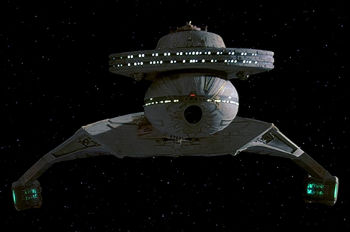
K’t’inga class (ST-06)
The K’t’inga class T’Ong was commanded by Captain K’Temoc on a deep space exploration mission that left Klingon space in 2290; in 2365, it returned after 75 years in hibernation, and would have attacked several nearby Federation colonies, if not for the intervention of Ambassador K’Ehleyr.[1]
References
- 1. “The Emissary.” Star Trek: The Next Generation, Episode 146. Television. 26 June 1989.
- 2. “Starships.” Star Trek Roleplaying Game, Book 4. Game. 2003. Decipher, Inc.
I.K.S. T’Acog IKC-7750

K’t’inga class (ST-06)
The K’t’inga class T’Acog was destroyed by Klingon criminals while en route to Qo’noS.[1, 2]
References
- 1. “Heart of Glory.” Star Trek: The Next Generation, Episode 120. Television. 21 March 1988.
- 2. “Starships.” Star Trek Roleplaying Game, Book 4. Game. 2003. Decipher, Inc.
Phoenix
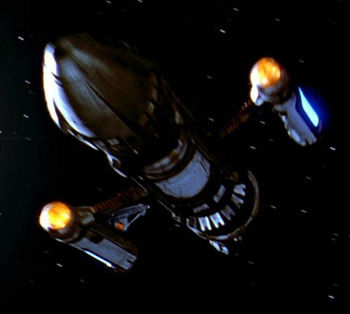
Phoenix (ST-08)
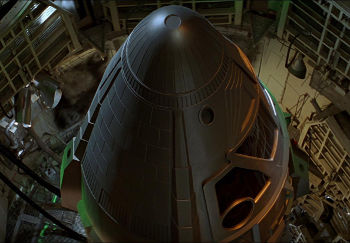
Phoenix (ST-08)
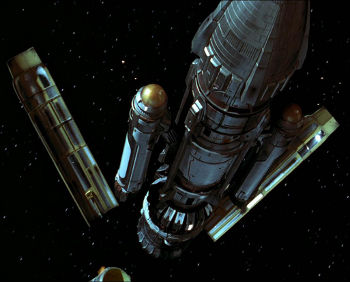
Phoenix (ST-08)
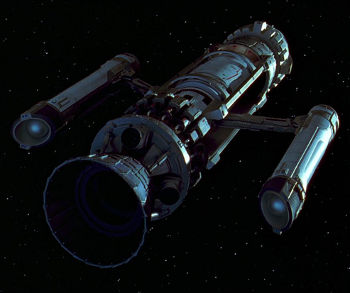
Phoenix (ST-08)
The first spacecraft launched from Earth with a faster-than-light engine, the Phoenix was built by noted space pioneer Zefram Cochrane and engineer Lily Sloane from an old Titan V nuclear missile, modified with a small crew cabin and twin warp nacelles. The Phoenix made its first historic warp flight on April 5, 2063, and was piloted by Cochrane, symbolically rising from the ashes of World War III, ushering in a new era for humanity. The flight of the Phoenix was directly responsible for Earth’s first contact with extraterrestrials, leading to Earth’s recovery from the postatomic horror. The Phoenix was later placed on display at the Smithsonian Institution, and was featured in a mandatory course taught at Starfleet Academy on basic warp design.[1]
References
- 1. Star Trek: First Contact. Film. 22 November 1996.
S.S. Mariposa NAR-7678
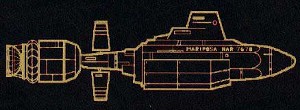
DY-500 class (TNG-144)
The DY-500 class Mariposa was launched on 27 November 2123, on a colonization mission to the Ficus Sector under Captain Walter Granger.[1]
› Continue reading
K’t’inga class

K’t’inga class (ST-06)
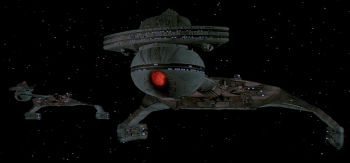
K’t’inga class (ST-01)
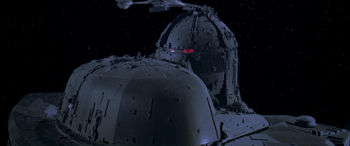
K’t’inga class command pod (ST-01)
The K’t’inga class,[2] which meant “bringer of destruction,” was introduced in mid-2269 and was a match for the Federation Constitution class and Romulan S’ten Vastam (V-6) class cruisers. This gave the Klingon Defense Force a slight advantage along its borders, and the Klingon Empire began to press the balance more aggressively. Both the Romulan Navy and Starfleet commissioned upgraded versions of their vessels shortly after the appearance of the K’t’inga class in order to hold the Klingons in check. Within two years after its introduction, 75% of all facilities producing the D-7 had been converted to manufacture the K’t’inga, allowing the Klingons to place more and more of these ships in sensitive areas.[3]
› Continue reading
DY-500 class

DY-500 class (TNG-144)
A sublight class ship from the 21st century, similar in design to the earlier DY-100 class[1] massing 3000 metric tons, which remained in use for nearly a century after being modified for early versions of warp drive. The S.S. Mariposa NAR-7678 was of the DY-500 class, and was launched in 2123.[2]
References
- 1. “Space Seed.” Star Trek, Episode 24. Television. 16 February 1967.
- 2. “Up the Long Ladder.” Star Trek: The Next Generation, Episode 144. Television. 22 May 1989.
U.S.S. Valiant NCC-75418
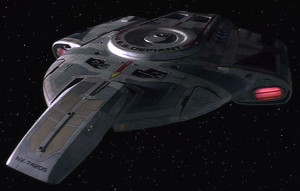
Defiant class (DS9-537)
The Defiant class[1] starship Valiant was assigned to Starfleet Battle Group Omega, which was assigned to rendezvous with the U.S.S. Enterprise NCC-1701-E near the Bassen Rift in an attempt to intercept Praetor Shinzon‘s Scimitar and prevent it from annihilating Earth. Fortunately, the Enterprise, with the aid of two Mogai class warbirds, was able to destroy the Scimitar before it entered Federation space.[2]
References
- 1. Star Trek: Armada. Game. 2000. Activision.
- 2. Star Trek: Nemesis. Film. 13 December 2002.
U.S.S. Ticonderoga

Defiant class (DS9-537)
The Defiant class starship Ticonderoga[2] arrived at the Ba’ku planet following the incident with the Son’a in 2374.[1]
References
- 1. Star Trek: Insurrection (Novelization). Novel. Pocket Books. December 1998.
- 2. Starfleet Command III. Game. Activision. 2002.
U.S.S. Neptune

Defiant class (DS9-537)
The Neptune was a Defiant class Federation starship. In 2376, the Neptune was commanded by Captain Landwaring and was the flagship of Task Force Javelin, which was sent to locate the source of the Genesis Wave. The Neptune was last heard from in the Boneyard, where it discovered a derelict shuttlepod.[1] The Neptune later arrived, derelict and abandoned, at Myrmidon. Commander Beverly Crusher of the U.S.S. Enterprise NCC-1701-E took a skeleton crew over to the Neptune, where they were infected by an unknown life form, which caused them to attack Myrmidon. The Enterprise transported the crew back aboard, and the Neptune was destroyed by the Genesis Wave.[2]
References
- 1. “The Genesis Wave, Book One.” Star Trek: The Next Generation. Novel. September 2000.
- 2. “The Genesis Wave, Book Two.” Star Trek: The Next Generation. Novel. April 2001.
Miranda class
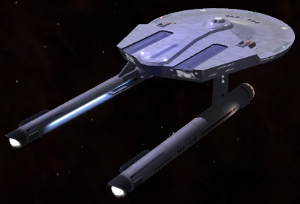
Miranda class (Legacy)
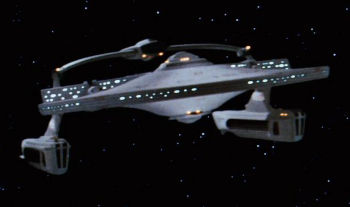
Miranda class (ST-02)
A Starfleet fixture of long-range scientific, supply, and exploratory missions for more than a century, Miranda class vessels probably logged more parsecs than any other single Federation vesel class. During the 23rd century, Starfleet Command placed an increasing emphasis on deep space exploration and surveying. The first ships launched after the inception of the exploratory vessel initiative, Miranda class vessels represent the most notable result of Starfleet’s renewed focus on exploration and discovery.[30] First commissioned during the period known as “The Great Awakening,” the Miranda class cruiser was in the forefront of that expansion effort. At the time, Starfleet itself was expanding in response to the changing and expanding economic and political goals of the Federation. To meet the demand of a larger navy, the Military Appropriations Committee authorized the development and testing of hundreds of vessel types, the Miranda among them.[6]
During this same period, the concepts of ship design were rapidly evolving and becoming more sophisticated, and the technology to build and operate starships was going through a revolution. Advances in all facets of the technology required to construct, maintain, and operate a starship were changing so rapidly that some ships were obsolete before they were completed. The Miranda design was changed no fewer than twelve times before the tooling and machining was begun. When these new cruisers were launched, they were only capable of performing three-year missions with resupply at one-year intervals. This made their dual-purpose role of research cruiser harder to perform. With the great distances that had to be travelled, they could not get more than six months travel time from a friendly outpost. This meant they could only advance as fast as the frontier was expanding. The class required some alterations during its trials and was to see many more changes after its commissioning, the last of which was a major refitting in the 2270s similar to that of the Constitution class.[6] Merging a host of diverse capabilities, versatility quickly became a hallmark of the class. Although Miranda class ships would primarily undertake scientific and exploratory missions, certain systems modules were swappable. These Miranda variants enjoyed great popularity in the early 24th century, and their expanded tactical and defensive systems were more than a match for most foes. Ships of this class participated in every major battle of the 24th century, often serving on the secondary or reserve battle lines.[30]
By the middle of the 24th century, Starfleet recommissioned many Miranda class vessels and sent them to surplus depots, scrapped them for parts, or used them as training vessels. Federation member planets and allied systems such as Altair and Betelgeuse first began to add reconditioned Miranda class ships to their own space fleets by the 2360s, after the active production life of these ships ceased. Hence, many Miranda class vessels continued to serve with distinction throughout Federation space and beyond for decades after their theoretical obsolescence.[30]
› Continue reading
Categories
- Animated Series (60)
- Articles (28)
- Books (447)
- Cast & Crew (79)
- Comics (22)
- DS9 (328)
- Early Voyages (125)
- Education (5)
- Enterprise (373)
- Excelsior (36)
- Food (19)
- Games (223)
- Klingon (70)
- Library (1,543)
- Logs (593)
- Lost Era (55)
- Medicine (18)
- Merrimac (1)
- Mirror (35)
- Miscellaneous (13)
- New Frontier (54)
- Next Generation (635)
- Original Series (681)
- Personnel (436)
- Places (369)
- Politics (12)
- Recreation (10)
- SCE (41)
- Science (1)
- Shatnerverse (9)
- Ships (455)
- Site Updates (98)
- Starfleet Academy (86)
- Stargazer (42)
- STO (61)
- Technology (45)
- Titan (59)
- To Boldly Go (1)
- TV/Film (214)
- Uncategorized (4)
- Vanguard (76)
- Voyager (236)
- Weapons (27)
- Xenology (54)